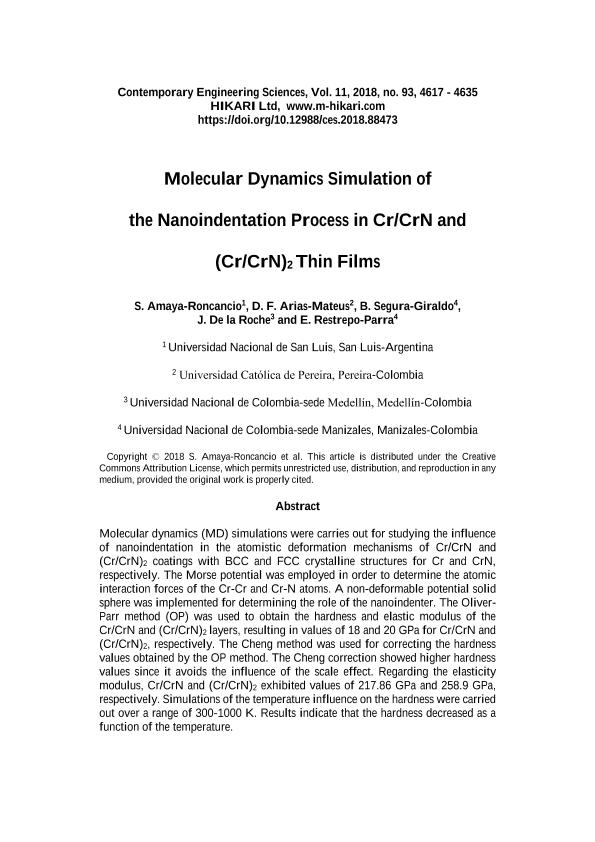Mostrar el registro sencillo del ítem
dc.contributor.author
Amaya Roncancio, Sebastian

dc.contributor.author
Arias Mateus, D. F.
dc.contributor.author
Segura Giraldo, B.
dc.contributor.author
de la Roche, J.
dc.contributor.author
Restrepo Parra, E.
dc.date.available
2019-10-18T21:42:55Z
dc.date.issued
2018-11
dc.identifier.citation
Amaya Roncancio, Sebastian; Arias Mateus, D. F.; Segura Giraldo, B.; de la Roche, J.; Restrepo Parra, E.; Molecular dynamics simulation of the nanoindentation process in Cr/CrN and (Cr/CrN)2 thin films; Hikari; Contemporary Engineering Sciences; 11; 93; 11-2018; 4617-4635
dc.identifier.issn
1313-6569
dc.identifier.uri
http://hdl.handle.net/11336/86516
dc.description.abstract
Molecular dynamics (MD) simulations were carries out for studying the influenceof nanoindentation in the atomistic deformation mechanisms of Cr/CrN and(Cr/CrN)2 coatings with BCC and FCC crystalline structures for Cr and CrN,respectively. The Morse potential was employed in order to determine the atomicinteraction forces of the Cr-Cr and Cr-N atoms. A non-deformable potential solidsphere was implemented for determining the role of the nanoindenter. The OliverParr method (OP) was used to obtain the hardness and elastic modulus of the Cr/CrN and (Cr/CrN)2 layers, resulting in values of 18 and 20 GPa for Cr/CrN and (Cr/CrN)2, respectively. The Cheng method was used for correcting the hardness values obtained by the OP method. The Cheng correction showed higher hardness values since it avoids the influence of the scale effect. Regarding the elasticity modulus, Cr/CrN and (Cr/CrN)2 exhibited values of 217.86 GPa and 258.9 GPa, respectively. Simulations of the temperature influence on the hardness were carried out over a range of 300-1000 K. Results indicate that the hardness decreased as a function of the temperature.
dc.format
application/pdf
dc.language.iso
eng
dc.publisher
Hikari
dc.rights
info:eu-repo/semantics/openAccess
dc.rights.uri
https://creativecommons.org/licenses/by/2.5/ar/
dc.subject
Molecular Dynamics
dc.subject
Hardness
dc.subject
Elastic Modulus
dc.subject
Temperature
dc.subject.classification
Ingeniería de los Materiales

dc.subject.classification
Ingeniería de los Materiales

dc.subject.classification
INGENIERÍAS Y TECNOLOGÍAS

dc.title
Molecular dynamics simulation of the nanoindentation process in Cr/CrN and (Cr/CrN)2 thin films
dc.type
info:eu-repo/semantics/article
dc.type
info:ar-repo/semantics/artículo
dc.type
info:eu-repo/semantics/publishedVersion
dc.date.updated
2019-10-15T14:13:17Z
dc.identifier.eissn
1314-7641
dc.journal.volume
11
dc.journal.number
93
dc.journal.pagination
4617-4635
dc.journal.pais
Bulgaria

dc.journal.ciudad
Rousse
dc.description.fil
Fil: Amaya Roncancio, Sebastian. Consejo Nacional de Investigaciones Científicas y Técnicas. Centro Científico Tecnológico Conicet - San Luis. Instituto de Física Aplicada "Dr. Jorge Andrés Zgrablich". Universidad Nacional de San Luis. Facultad de Ciencias Físico Matemáticas y Naturales. Instituto de Física Aplicada "Dr. Jorge Andrés Zgrablich"; Argentina
dc.description.fil
Fil: Arias Mateus, D. F.. Universidad Católica de Pereira; Colombia
dc.description.fil
Fil: Segura Giraldo, B.. Universidad Nacional de Colombia; Colombia
dc.description.fil
Fil: de la Roche, J.. Universidad Nacional de Colombia; Colombia
dc.description.fil
Fil: Restrepo Parra, E.. Universidad Nacional de Colombia; Colombia
dc.journal.title
Contemporary Engineering Sciences
dc.relation.alternativeid
info:eu-repo/semantics/altIdentifier/url/http://www.m-hikari.com/ces/ces2018/ces93-96-2018/88473.html
dc.relation.alternativeid
info:eu-repo/semantics/altIdentifier/doi/https://doi.org/10.12988/ces.2018.88473
Archivos asociados
